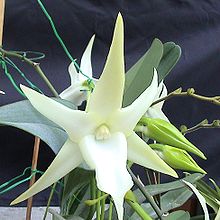Angraecum sesquipedale
[1][2] It is noteworthy for its long spur and its association with the naturalist Charles Darwin, who surmised that the flower was pollinated by a then undiscovered moth with a proboscis whose length was unprecedented at the time.
[11] It inhabits a drier habitat, in a more southern range, growing terrestrially in the white sand of littoral forests which are now being mined for titanium dioxide.
[12] It is often found in lowlands in Madagascar at altitudes below 400–500 feet (120–150 m), near the east coast of the island, and on trees that are at the edge of forests.
[22] The specific epithet sesquipedale is Latin for "one-and-a-half-feet-long", referring to the distance between the end of the spur and the very top of the dorsal sepal.
After being sent several flowers of A. sesquipedale by James Bateman,[29] Darwin noted the defining characteristic of the species, its extremely long spur.
[30] From his observations, Darwin surmised, in his 1862 publication On the Various Contrivances by Which British and Foreign Orchids Are Fertilized by Insects, and On the Good Effects of Intercrossing, that there must be a pollinator moth with a proboscis long enough to reach the nectar at the end of the spur.
Only after placing a cylinder with a diameter of 1⁄10 of an inch (2.5 mm) down the full length of the spur was he able to detach the pollinia upon retracting it.
[32] For some time after this prediction the notion of a pollinator with a 35 cm long proboscis was ridiculed and generally not believed to exist.
[33][34] After Darwin's publication, George Campbell, 8th Duke of Argyll published a book in 1867 titled, The Reign of Law, in which he argued that the complexity of this species implied that it was created by a supernatural being.
[35] Alfred Russel Wallace replied in the same year with a paper he titled "Creation by Law", setting out in detail a sequence through which the moth and the flower could have coevolved with no guidance other than natural selection.
[39] In 1873 William Alexander Forbes wrote an article in the journal Nature asking readers if they knew of the moth predicted by Darwin.
A second inquiry into the existence of the pollinator moth was made in the 30 January 1907 issue of the journal Nature by E. W. Swanton.
Presumably still unaware of Rothschild and Jordan's discovery, Wallace responded stating that he didn't know of a suitable pollinator in Madagascar, but that he had heard of one from East Africa with a long enough proboscis.
There was also another explanation why the spur of A. sesquipedale grew so long proposed by Thomas Belt in his 1874 book The Naturalist in Nicaragua.
[50] Belt suggested that the spur grew long in order to prevent other moths with shorter proboscises from drinking the nectar.
Then the moth backs up over a foot and unrolls its proboscis, then flies forward, inserting it into a cleft in the rostellum which leads to the spur while gripping the labellum.
[21] An alternative path by which A. sesquipedale could have evolved that differed with Darwin and Wallace's explanation was proposed by Lutz Thilo Wasserthal in 1997.
[5] According to Wasserthal, hawk moths could have evolved long proboscises as a predatory avoidance strategy from heteropodid spiders.
Based on this reasoning moths with longer tongues would be less at risk when pollinating flowers since they would be farther away and thus a more challenging target for jumping spiders.
[55] In 2017, Netz and Renner provided molecular clock-dated phylogenies that include 62 of 144 Angraecum species on Madagascar and all nine Madagascan Sphinginae.
Clock models using either rate- or fossil-based calibrations imply that the Madagascan subspecies praedicta and the African subspecies morganii diverged 7.4 ± 2.8 Mya, which overlaps the divergence of A. sesquipedale from its sister, A. sororium, namely 7.5 ± 5.2 Mya; since both these orchids have extremely long spurs, long spurs likely existed before that.
[56] Additionally, A. sesquipedale is seldom grown in private collections, despite its enormous importance to Darwin's concept of coevolution and subsequently the fields of botany and evolutionary biology.
[13][19] In order to stimulate heavy flower production it is important that the light intensity be greatest between September and November.
[13] Angraecum sesquipedale is commonly found to have a slow growth habit, but the orchid can be expected to produce flowers even before it has reached an adult size.
When a mature plant is disturbed it frequently loses many of its lower leaves and reverts to only producing one or two flowers at a time.
[13] To avoid these problems it is commonly advised that the orchid be planted in a coarse medium such as fir bark, crock, or charcoal to minimize disturbances to the roots.
[3] The first Angraecum hybrid was created by John Seden, an employee of Veitch Nurseries, and exhibited for the first time on 10 January 1899.





